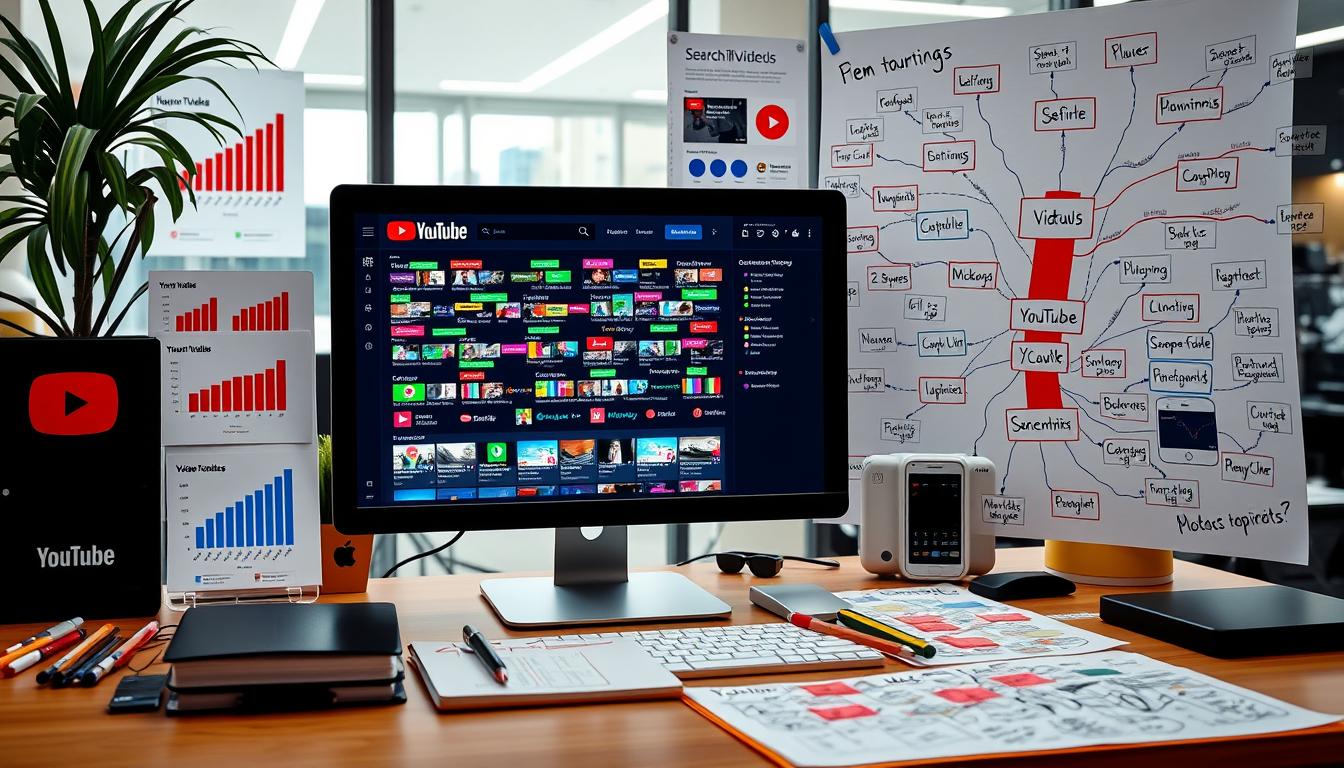YouTube success hinges on effective keyword research. This guide explores essential tools for finding winning tags. We’ll help you optimize content and boost channel growth in 2024.
We’ll cover YouTube keyword research basics and advanced SEO techniques. You’ll gain insights to make your videos more discoverable and engaging. This guide is for both new and experienced YouTubers.
Key Takeaways
- Discover the essential concepts of YouTube keyword research and how they differ from traditional Google searches
- Explore popular YouTube tag generators and research tools to find the most relevant and high-performing keywords
- Learn advanced SEO techniques to analyze competitor tags, understand tag relevancy, and create a winning keyword strategy
- Optimize your video tags and metadata for maximum visibility and discoverability on YouTube
- Leverage YouTube analytics to track keyword performance and continuously refine your keyword strategy
Understanding YouTube Keyword Research Fundamentals
YouTube video optimization begins with grasping the key role of keywords in content discovery. Keywords are vital for connecting creators with engaged viewers. YouTube’s search algorithm heavily relies on strategic keyword use.
The Role of Keywords in Video Discovery
Keywords act as bridges, helping viewers find your content. YouTube’s algorithm checks your video’s metadata for relevance. This includes titles, descriptions, and tags.
Optimizing keywords can boost your video’s visibility. This increases the chances of your target audience discovering your content.
Why Proper Tag Selection Matters
Carefully crafting video tags is crucial for YouTube video optimization and YouTube ranking factors. Tags help YouTube grasp your content’s context and subject matter. This allows the platform to show your videos in relevant searches.
Choosing the right tags can make a big difference. It can help your video rise to the top of search rankings.
Search Intent on YouTube vs. Google
Search behavior on YouTube and Google shares similarities but also has key differences. YouTube users often have more specific, action-oriented search goals. They often seek how-to guides, tutorials, or entertaining content.
Understanding these platform-specific patterns is crucial. It helps create a successful YouTube video optimization strategy that matches your audience’s needs.
“Effective YouTube keyword research is the foundation for building a content strategy that resonates with your target audience and maximizes your visibility on the platform.”
Keyword Tools for YouTube: Essential Features and Benefits
Optimizing YouTube content requires the right keyword tools. These tools offer valuable insights to enhance your video metadata. They can drive more views and engagement on your channel.
YouTube-specific keyword tools analyze the platform’s unique search patterns. YouTube analytics tools provide data-driven recommendations for effective tags, titles, and descriptions. These tools help maximize your video’s discoverability on the platform.
Understanding user search behavior allows you to optimize YouTube video metadata. This ensures your videos reach the right audience. Keyword tools can uncover high-performing, relevant keywords for your content.
- Keyword research and suggestion tools that surface high-performing, relevant keywords for your videos
- Competitor analysis capabilities to reverse-engineer successful videos and understand what tags and keywords are working for them
- Insights into the search intent and behaviors of your target audience on YouTube
- Real-time performance tracking and optimization recommendations to continually refine your video metadata
These YouTube analytics tools help develop a comprehensive keyword strategy. They align your content with your audience’s interests. This drives more views, subscribers, and overall growth for your channel.
Investing in the right tools can boost your video metadata optimization. It positions your content for success in the competitive YouTube landscape.
“Effective keyword research and optimization are essential for standing out in the crowded YouTube space. The right tools can be a game-changer for your video content strategy.”
Top Free YouTube Tag Generators and Research Tools
Great YouTube videos need more than just content. They also need good metadata and tags. Free tools can help you find the right keywords and tags.
These tools make your YouTube strategy stronger. They help your videos get seen by more people.
VidIQ Overview and Features
VidIQ is a popular free YouTube tag generator. It offers many helpful features for content creators.
- Automatic tag suggestions based on your video’s title and description
- Competitor tag analysis to see what keywords are working for similar videos
- Detailed YouTube channel analytics and performance insights
- Chrome and Firefox browser extensions for easy access
TubeBuddy Tag Suggestions
TubeBuddy is another free tool for YouTube optimization. It has a tag suggestion tool that analyzes your video content.
This tool gives you a list of relevant, high-performing keywords. You can use these keywords to improve your video’s reach.
YouTube’s Native Search Tools
Don’t forget about YouTube’s own search features. They can be very helpful too. Type in your target keywords and look at the autocomplete suggestions.
This shows you how users search on YouTube. You can also check the tags used by your competitors.
Use these free tools to boost your video’s visibility. Keyword research and video tags are key to growing your YouTube audience.

Advanced YouTube SEO Techniques for Tag Optimization
Optimizing YouTube video tags is vital for boosting visibility in search results. Advanced YouTube SEO keywords and YouTube video optimization techniques can elevate your strategy. These methods enhance your content’s relevance and performance.
Semantic search is a key tactic. Include related keywords in your tags to improve content relevance. This boosts your video’s ranking and increases its chances of appearing in suggested feeds.
Long-tail keywords are another powerful technique. These specific phrases drive targeted traffic to your videos. They lead to higher click-through rates and engagement.
- Utilize LSI (Latent Semantic Indexing) keywords to expand your tag list and cover a broader range of related topics.
- Experiment with different tag orders and placements to see what resonates best with your audience.
- Monitor your video’s performance and continuously refine your tag strategy based on insights from YouTube Analytics.
Mastering these advanced techniques can unlock new opportunities. They enhance your video’s discoverability and reach on YouTube. Continuously refine your strategy for optimal results.
“Effective tag optimization is the key to unlocking your video’s full potential on YouTube.”
Analyzing Competitor Tags and Video Metadata
Studying your rivals’ methods is key to improving your YouTube content. By examining successful videos’ tags and metadata, you can boost your own strategy. This approach offers valuable insights for your YouTube content plan.
Reverse Engineering Successful Videos
Find top videos in your field. Look at their titles, descriptions, and tags. These elements reveal keywords that attract your target audience.
Use this information to create content that matches user searches. This approach helps align your videos with viewer preferences.
Understanding Tag Relevancy Scores
YouTube rates the relevance of your video tags. This “tag relevancy score” affects your video’s visibility. Keep an eye on these scores to refine your tag choices.
Using impactful keywords can boost your video’s discoverability. Focus on tags that score well to improve your content’s reach.
Competitive Analysis Tools
Tools like VidIQ and TubeBuddy simplify competitor analysis. They provide insights into successful creators’ metadata strategies. Use these platforms to compare your content with industry leaders.
| Tool | Key Features | Pricing |
|---|---|---|
| VidIQ |
|
|
| TubeBuddy |
|
|
These tools and methods offer deep insights into competitors’ strategies. Apply this knowledge to enhance your own YouTube content strategy. With practice, you’ll create more engaging and discoverable videos.
Creating a YouTube Keyword Strategy That Works
An effective YouTube content strategy needs strong keyword research and optimization. The right keywords can boost your channel’s visibility and rankings. This approach can drive more targeted traffic to your videos.
A winning YouTube keyword strategy involves three steps. These are research, implementation, and ongoing optimization. Let’s dive into each step:
- Keyword Research: Find search terms your audience uses to discover content like yours. Tools like VidIQ and TubeBuddy can help uncover valuable keywords. Look for high-volume, low-competition terms that match your niche.
- Keyword Implementation: Use your chosen keywords in video titles, descriptions, and tags. Keep tags short and relevant. Focus on terms that best describe your content.
- Ongoing Optimization: Track your video’s performance and key metrics. Use this data to refine your keyword strategy. Test different variations to improve your YouTube ranking factors and YouTube content strategy.
This approach aligns your YouTube keyword strategy with your channel’s goals. It helps your content resonate with viewers and stand out on YouTube.
| Key Factors for Effective YouTube Keyword Strategy | Best Practices |
|---|---|
| Keyword Research |
|
| Keyword Implementation |
|
| Ongoing Optimization |
|
These best practices will help you build a strong YouTube keyword strategy. Your content will reach the right audience. Your channel will grow steadily over time.

Best Practices for YouTube Video Tag Implementation
Optimizing YouTube video tags boosts search visibility and discoverability. Effective tags drive more views and engagement. Let’s explore key considerations for YouTube video optimization.
Tag Character Limits and Formatting
YouTube allows 500 characters for video tags. Keep them concise and focused. Use 2-3 word tags with relevant keywords describing your content.
Avoid tag stuffing, as it can hurt video performance. Format tags properly, using commas to separate each one.
Priority Order for Tags
- Place high-volume keywords at the beginning of your tag list.
- Include variations of your primary keyword to cover different search queries.
- Incorporate related topics and subtopics to expand your video’s reach.
- Use specific, long-tail keywords to target niche audiences.
Common Tagging Mistakes to Avoid
- Irrelevant or misleading tags that don’t accurately represent your video content.
- Keyword stuffing by including an excessive number of tags.
- Duplicate tags that provide no additional value to your optimization efforts.
- Failure to update tags as your video content or audience interests evolve.
Implement these YouTube video tags practices to boost discoverability. Refine your strategy to stay competitive. Effective tagging is an ongoing process.
Leveraging YouTube Analytics for Keyword Performance
Mastering YouTube analytics tools is vital for content creators. It helps fine-tune YouTube ranking factors and drives long-term success. These tools provide valuable data to optimize your keyword strategy and boost video visibility.
YouTube Analytics tracks keyword performance effectively. It monitors metrics like impressions, click-through rates, and view duration. This data shows which tags resonate with your audience and which need updating.
- Identify top-performing keywords: Analyze keywords driving most impressions and clicks. Use this info to strengthen your most effective tags.
- Pinpoint underperforming keywords: Recognize keywords not generating desired engagement. Consider replacing them with more relevant, search-friendly alternatives.
- Discover new keyword opportunities: Explore related and emerging keywords your target audience searches for. Incorporate them into your video optimization strategy.
YouTube analytics tools offer insights on viewer behavior too. This data helps refine your YouTube ranking factors. It enables you to create videos that truly resonate with your target audience.
| Metric | Significance |
|---|---|
| Watch time | Indicates viewer engagement and content relevance |
| Audience retention | Reveals areas where viewers are dropping off, allowing you to improve content structure and pacing |
| Traffic sources | Highlights the most effective channels for driving traffic to your videos, informing your promotion and distribution strategies |
YouTube analytics tools offer powerful insights for content creators. Use them to optimize your ranking factors and build a thriving video strategy. This approach will resonate with your audience and drive tangible results.
Trending Topics and Seasonal Keywords for YouTube
YouTube success requires understanding trends and seasonal content opportunities. Monitor popular topics and current events to align your videos. This strategy attracts a larger, more engaged audience.
Finding Trending Content Opportunities
Identifying trending topics on YouTube is crucial for content strategy. Use YouTube’s search tools and platforms like Google Trends. These reveal the latest search queries and viral content ideas.
Real-time insights help create timely, relevant videos. This approach resonates with viewers and boosts your channel’s visibility.
Seasonal Content Planning
YouTube’s audience responds to seasonal trends and cultural events. Align your content calendar with these themes to increase engagement. Develop a strategy that anticipates seasonal viewership spikes.
This approach helps you stay ahead and maximize visibility. Focus on high-impact periods for better results.

